engine INFINITI QX60 2014 Owner's Manual
[x] Cancel search | Manufacturer: INFINITI, Model Year: 2014, Model line: QX60, Model: INFINITI QX60 2014Pages: 547, PDF Size: 7.39 MB
Page 523 of 547

LOADING TIPS
●The GVW must not exceed GVWR
or GAWR as specified on the
F.M.V.S.S./C.M.V.S.S. certification
label.
●Do not load the front and rear axle to
the GAWR. Doing so will exceed the
GVWR.
WARNING
●Properly secure all cargo with
ropes or straps to help prevent it
from sliding or shifting. Do not
place cargo higher than the seat-
backs. In a sudden stop or colli-
sion, unsecured cargo could
cause personal injury.
●Do not load your vehicle any
heavier than the GVWR or the
maximum front and rear GAWRs.
If you do, parts of your vehicle can
break, tire damage could occur,
or it can change the way your
vehicle handles. This could result
in loss of control and cause per-
sonal injury.●Overloading not only can shorten
the life of your vehicle and the
tire, but can also cause unsafe
vehicle handling and longer brak-
ing distances. This may cause a
premature tire failure which
could result in a serious accident
and personal injury. Failures
caused by overloading are not
covered by the vehicle’s warranty.MEASUREMENT OF WEIGHTS
Secure loose items to prevent weight
shifts that could affect the balance of your
vehicle. When the vehicle is loaded, drive
to a scale and weigh the front and the rear
wheels separately to determine axle
loads. Individual axle loads should not ex-
ceed either of the gross axle weight rat-
ings (GAWR) . The total of the axle loads
should not exceed the gross vehicle
weight rating (GVWR) . These ratings are
given on the vehicle certification label. If
weight ratings are exceeded, move or re-
move items to bring all weights below the
ratings.
WARNING
Overloading or improper loading of a
trailer and its cargo can adversely affect
vehicle handling, braking and perfor-
mance and may lead to accidents.
CAUTION
●Do not tow a trailer or haul a heavy load
for the first 500 miles (800 km) . Your
engine, axle or other parts could be
damaged.
●For the first 500 miles (800 km) that you
tow a trailer, do not drive over 50 mph
(80 km/h) and do not make starts at full
throttle. This helps the engine and other
parts of your vehicle wear in at the
heavier loads.
Your new vehicle was designed to be used pri-
marily to carry passengers and cargo. Remember
that towing a trailer places additional loads on
your vehicle’s engine, drive train, steering, brak-
ing and other systems.
An INFINITI Towing Guide (U.S. only) is available
on the website atwww.InfinitiUSA.com.This
guide includes information on trailer towing ca-
pability and the special equipment required for
proper towing.
TOWING A TRAILER
Technical and consumer information9-17
Page 524 of 547

MAXIMUM LOAD LIMITS
Maximum trailer loads
Never allow the total trailer load to exceed the
value specified in the following Towing
Load/Specification Chart found later in this sec-
tion. The total trailer load equals trailer weight
plus its cargo weight.
●When towing a trailer load of 3,500 lbs.
(1,587 kg) or more, trailers with a brake
system MUST be used.
The maximum Gross Combined Weight Rating
(GCWR) should not exceed the value specified
in the following Towing Load/Specification Chart.
The GCWR equals the combined weight of the
towing vehicle (including passengers and cargo)
plus the total trailer load. Towing loads greater
than these or using improper towing equipment
could adversely affect vehicle handling, braking
and performance.
The ability of your vehicle to tow a trailer is not
only related to the maximum trailer loads, but also
the places you plan to tow. Tow weights appro-
priate for level highway driving may have to be
reduced for low traction situations (for example,
on slippery boat ramps) .Temperature conditions can also affect towing.
For example, towing a heavy trailer in high outside
temperatures on graded roads can affect engine
performance and cause overheating. The engine
protection mode, which helps reduce the chance
of engine damage, could activate and automati-
cally decrease engine power. Vehicle speed may
decrease under high load. Plan your trip carefully
to account for trailer and vehicle load, weather
and road conditions.
WARNING
Overheating can result in reduced engine
power and vehicle speed. The reduced
speed may be lower than other traffic,
which could increase the chance of a col-
lision. Be especially careful when driving.
If the vehicle cannot maintain a safe driv-
ing speed, pull to the side of the road in a
safe area. Allow the engine to cool and
return to normal operation. See “If your
vehicle overheats” in the “In case of emer-
gency” section of this manual.
CAUTION
Vehicle damage resulting from improper
towing procedures is not covered by
INFINITI warranties.
LTI2030
9-18Technical and consumer information
Page 532 of 547

●Always secure items in the trailer to prevent
load shift while driving.
●Keep the cargo load as low as possible in
the trailer to keep the trailer center of gravity
low.
●Load the trailer so approximately 60% of the
trailer load is in the front half and 40% is in
the back half. Also make sure the load is
balanced side to side.
●Check your hitch, trailer tire pressure, ve-
hicle tire pressure, trailer light operation, and
trailer wheel lug nuts every time you attach a
trailer to the vehicle.
●Be certain your rearview mirrors conform to
all federal, state or local regulations. If not,
install any mirrors required for towing before
driving the vehicle.
●Determine the overall height of the vehicle
and trailer so the required clearance is
known.
Trailer towing tips
In order to gain skill and an understanding of the
vehicle’s behavior, you should practice turning,
stopping and backing up in an area which is free
from traffic. Steering stability and braking perfor-
mance will be somewhat different than under
normal driving conditions.●Always secure items in the trailer to prevent
load shift while driving.
●Lock the trailer hitch coupler with a pin or
lock to prevent the coupler from inadver-
tently becoming unlatched.
●Avoid abrupt starts, acceleration or stops.
●Avoid sharp turns or lane changes.
●Always drive your vehicle at a moderate
speed.
●When backing up, hold the bottom of the
steering wheel with one hand. Move your
hand in the direction in which you want the
trailer to go. Make small corrections and
back up slowly. If possible, have someone
guide you when you are backing up.
Always block the wheels on both vehicle and
trailer when parking. Parking on a slope is not
recommended; however, if you must do so:
CAUTION
If you move the shift selector to the P
(Park) position before blocking the
wheels and applying the parking brake,
transmission damage could occur.1. Apply and hold the brake pedal.
2. Have someone place blocks on the downhill
side of the vehicle and trailer wheels.
3. After the wheel blocks are in place, slowly
release the brake pedal until the blocks ab-
sorb the vehicle load.
4. Apply the parking brake.
5. Shift the transmission into P (Park) .
6. Turn off the engine.
To drive away:
1. Start the vehicle.
2. Apply and hold the brake pedal.
3. Shift the transmission into gear.
4. Release the parking brake.
5. Drive slowly until the vehicle and trailer are
clear from the blocks.
6. Apply and hold the brake pedal.
7. Have someone retrieve and store the blocks.
9-26Technical and consumer information
Page 533 of 547

●While going downhill, the weight of the
trailer pushing on the tow vehicle may de-
crease overall stability. Therefore, to main-
tain adequate control, reduce your speed
and shift to a lower gear. Avoid long or
repeated use of the brakes when descend-
ing a hill, as this reduces their effectiveness
and could cause overheating. Shifting to a
lower gear instead provides “engine brak-
ing” and reduces the need to brake as fre-
quently.
●If the engine coolant temperature rises to a
high temperature, refer to “If your vehicle
overheats” in the “In case of emergency”
section of this owner’s manual.
●Trailer towing requires more fuel than normal
circumstances.
●Avoid towing a trailer for your vehicle’s first
500 miles (805 km) .
●For the first 500 miles (805 km) that you do
tow, do not drive over 50 MPH (80 km/h).
●Have your vehicle serviced more often than
at intervals specified in the recommended
Maintenance Schedule in the “INFINITI Ser-
vice and Maintenance Guide”.●When making a turn, your trailer wheels will
be closer to the inside of the turn than your
vehicle wheels. To compensate for this,
make a larger than normal turning radius
during the turn.
●Crosswinds and rough roads will adversely
affect vehicle/trailer handling, possibly caus-
ing vehicle sway. When being passed by
larger vehicles, be prepared for possible
changes in crosswinds that could affect ve-
hicle handling.
Do the following if the trailer begins to sway:
1. Take your foot off the accelerator pedal to
allow the vehicle to coast and steer as
straight ahead as the road conditions allow.
This combination will help stabilize the ve-
hicle
– Do not correct trailer sway by steering or
applying the brakes.
2. When the trailer sway stops, gently apply the
brakes and pull to the side of the road in a
safe area.
3. Try to rearrange the trailer load so it is bal-
anced as described earlier in this section.●Be careful when passing other vehicles.
Passing while towing a trailer requires con-
siderably more distance than normal pass-
ing. Remember, the length of the trailer must
also pass the other vehicle before you can
safely change lanes.
●Downshift the transmission to a lower gear
for engine braking when driving down steep
or long hills. This will help slow the vehicle
without applying the brakes.
●Avoid holding the brake pedal down too long
or too frequently. This could cause the
brakes to overheat, resulting in reduced
braking efficiency.
●Increase your following distance to allow for
greater stopping distances while towing a
trailer. Anticipate stops and brake gradually.
●INFINITI recommends that the cruise control
not be used while towing a trailer.
●Some states or provinces have specific
regulations and speed limits for vehicles that
are towing trailers. Obey the local speed
limits.
●Check your hitch, trailer wiring harness con-
nections, and trailer wheel lug nuts after
50 miles (80 km) of travel and at every break.
Technical and consumer information9-27
Page 537 of 547
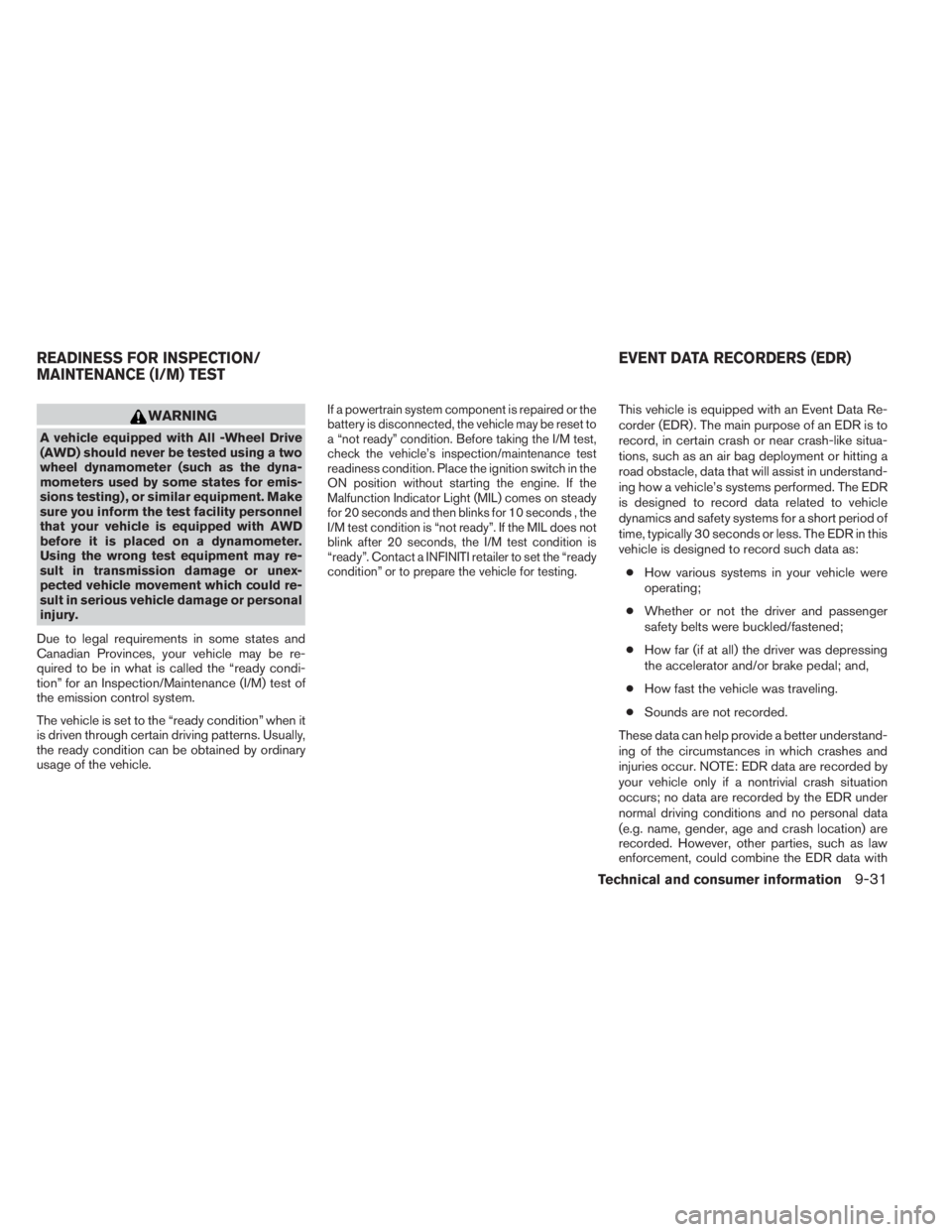
WARNING
A vehicle equipped with All -Wheel Drive
(AWD) should never be tested using a two
wheel dynamometer (such as the dyna-
mometers used by some states for emis-
sions testing) , or similar equipment. Make
sure you inform the test facility personnel
that your vehicle is equipped with AWD
before it is placed on a dynamometer.
Using the wrong test equipment may re-
sult in transmission damage or unex-
pected vehicle movement which could re-
sult in serious vehicle damage or personal
injury.
Due to legal requirements in some states and
Canadian Provinces, your vehicle may be re-
quired to be in what is called the “ready condi-
tion” for an Inspection/Maintenance (I/M) test of
the emission control system.
The vehicle is set to the “ready condition” when it
is driven through certain driving patterns. Usually,
the ready condition can be obtained by ordinary
usage of the vehicle.
If a powertrain system component is repaired or the
battery is disconnected, the vehicle may be reset to
a “not ready” condition. Before taking the I/M test,
check the vehicle’s inspection/maintenance test
readiness condition. Place the ignition switch in the
ON position without starting the engine. If the
Malfunction Indicator Light (MIL) comes on steady
for 20 seconds and then blinks for 10 seconds , the
I/M test condition is “not ready”. If the MIL does not
blink after 20 seconds, the I/M test condition is
“ready”. Contact a INFINITI retailer to set the “ready
condition” or to prepare the vehicle for testing.This vehicle is equipped with an Event Data Re-
corder (EDR) . The main purpose of an EDR is to
record, in certain crash or near crash-like situa-
tions, such as an air bag deployment or hitting a
road obstacle, data that will assist in understand-
ing how a vehicle’s systems performed. The EDR
is designed to record data related to vehicle
dynamics and safety systems for a short period of
time, typically 30 seconds or less. The EDR in this
vehicle is designed to record such data as:
●How various systems in your vehicle were
operating;
●Whether or not the driver and passenger
safety belts were buckled/fastened;
●How far (if at all) the driver was depressing
the accelerator and/or brake pedal; and,
●How fast the vehicle was traveling.
●Sounds are not recorded.
These data can help provide a better understand-
ing of the circumstances in which crashes and
injuries occur. NOTE: EDR data are recorded by
your vehicle only if a nontrivial crash situation
occurs; no data are recorded by the EDR under
normal driving conditions and no personal data
(e.g. name, gender, age and crash location) are
recorded. However, other parties, such as law
enforcement, could combine the EDR data with
READINESS FOR INSPECTION/
MAINTENANCE (I/M) TESTEVENT DATA RECORDERS (EDR)
Technical and consumer information9-31
Page 539 of 547
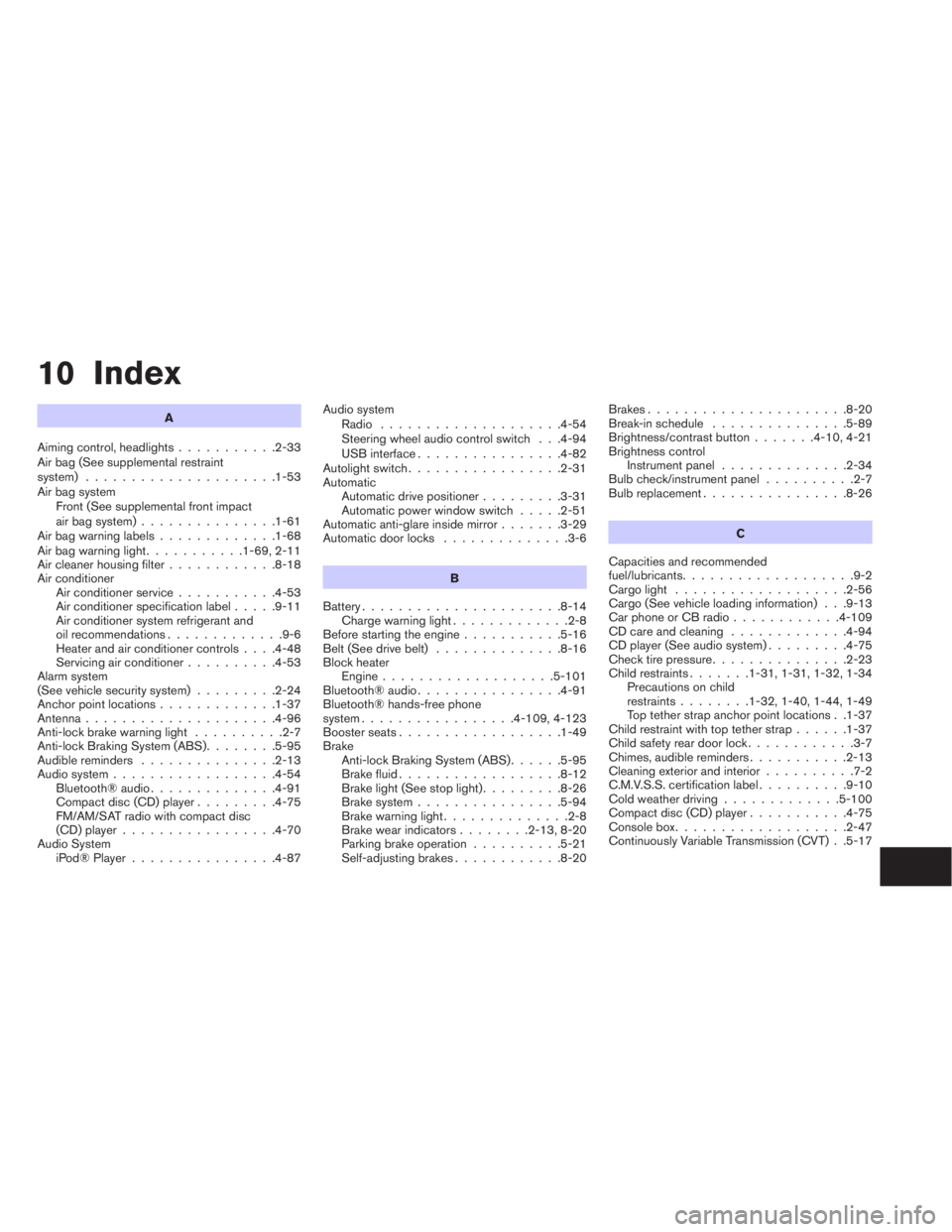
10 Index
A
Aiming control, headlights...........2-33
Air bag (See supplemental restraint
system) .....................1-53
Air bag system
Front (See supplemental front impact
air bag system)...............1-61
Airbagwarninglabels.............1-68
Airbagwarninglight...........1-69,2-11
Air cleaner housing filter............8-18
Air conditioner
Air conditioner service...........4-53
Air conditioner specification label.....9-11
Air conditioner system refrigerant and
oil recommendations.............9-6
Heater and air conditioner controls....4-48
Servicing air conditioner..........4-53
Alarm system
(See vehicle security system).........2-24
Anchor point locations.............1-37
Antenna.....................4-96
Anti-lock brake warning light..........2-7
Anti-lock Braking System (ABS)........5-95
Audible reminders...............2-13
Audio system..................4-54
Bluetooth®audio..............4-91
Compact disc (CD) player.........4-75
FM/AM/SAT radio with compact disc
(CD)player.................4-70
Audio System
iPod®Player................4-87Audio system
Radio ....................4-54
Steering wheel audio control switch . . .4-94
USB interface................4-82
Autolight switch.................2-31
Automatic
Automatic drive positioner.........3-31
Automatic power window switch.....2-51
Automatic anti-glare inside mirror.......3-29
Automatic door locks..............3-6
B
Battery......................8-14
Charge warning light.............2-8
Before starting the engine...........5-16
Belt (See drive belt)..............8-16
Block heater
Engine...................5-101
Bluetooth®audio................4-91
Bluetooth® hands-free phone
system.................4-109, 4-123
Boosterseats..................1-49
Brake
Anti-lock Braking System (ABS)......5-95
Brake fluid..................8-12
Brake light (See stop light).........8-26
Brake system................5-94
Brake warning light..............2-8
Brake wear indicators........2-13,8-20
Parking brake operation..........5-21
Self-adjusting brakes............8-20Brakes......................8-20
Break-inschedule ...............5-89
Brightness/contrast button.......4-10,4-21
Brightness control
Instrument panel..............2-34
Bulb check/instrument panel..........2-7
Bulbreplacement................8-26
C
Capacities and recommended
fuel/lubricants...................9-2
Cargolight ...................2-56
Cargo (See vehicle loading information) . . .9-13
Car phone or CB radio............4-109
CD care and cleaning.............4-94
CD player (See audio system).........4-75
Check tire pressure...............2-23
Child restraints.......1-31,1-31,1-32,1-34
Precautions on child
restraints........1-32,1-40,1-44,1-49
Top tether strap anchor point locations . .1-37
Child restraint with top tether strap......1-37
Child safety rear door lock............3-7
Chimes,audiblereminders...........2-13
Cleaning exterior and interior..........7-2
C.M.V.S.S. certification label..........9-10
Cold weather driving.............5-100
Compact disc (CD) player...........4-75
Consolebox...................2-47
Continuously Variable Transmission (CVT) . .5-17
Page 540 of 547
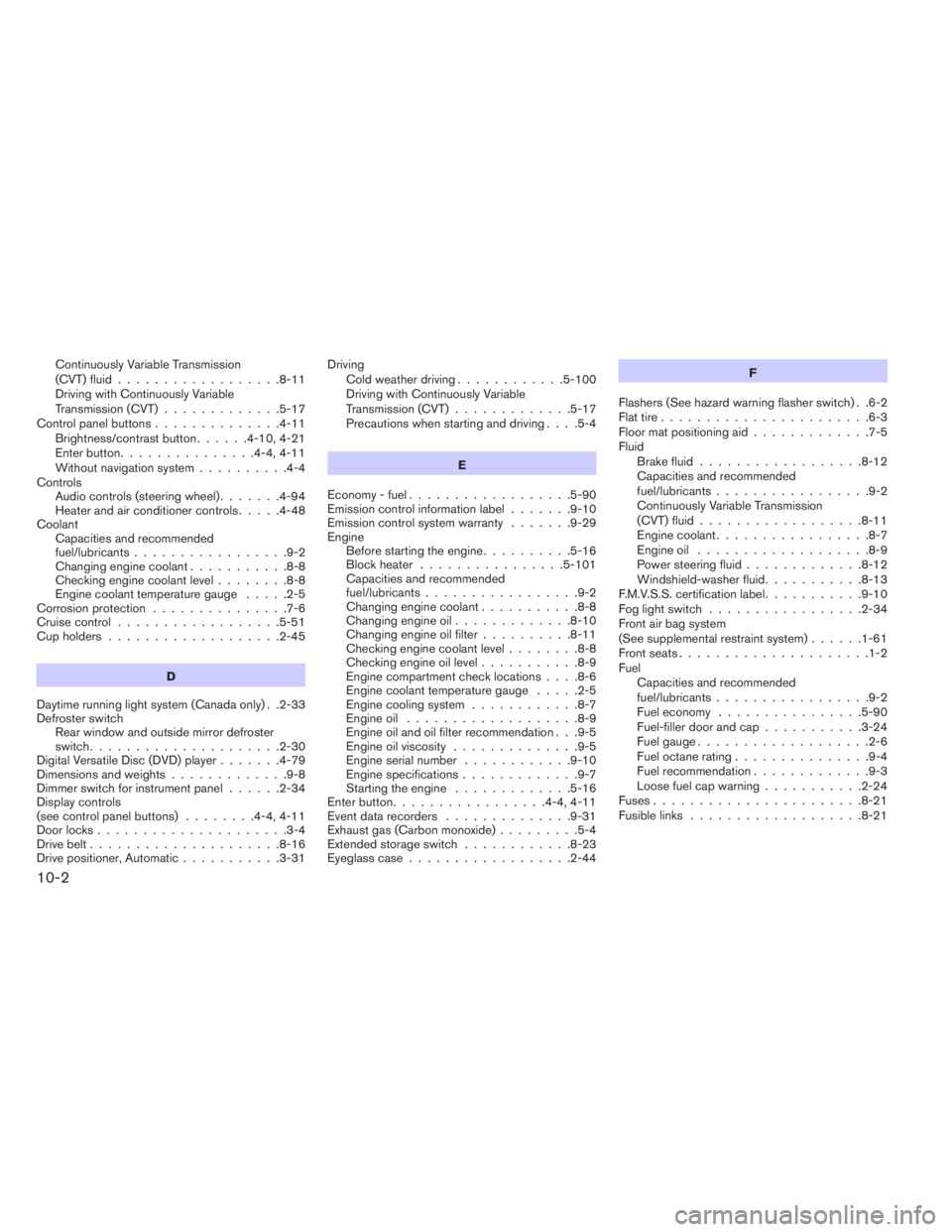
Continuously Variable Transmission
(CVT) fluid..................8-11
Driving with Continuously Variable
Transmission (CVT).............5-17
Control panel buttons..............4-11
Brightness/contrast button......4-10,4-21
Enterbutton...............4-4,4-11
Without navigation system..........4-4
Controls
Audiocontrols(steeringwheel).......4-94
Heater and air conditioner controls.....4-48
Coolant
Capacities and recommended
fuel/lubricants.................9-2
Changing engine coolant...........8-8
Checking engine coolant level........8-8
Engine coolant temperature gauge.....2-5
Corrosionprotection ...............7-6
Cruisecontrol..................5-51
Cupholders...................2-45
D
Daytime running light system (Canada only) . .2-33
Defroster switch
Rear window and outside mirror defroster
switch.....................2-30
Digital Versatile Disc (DVD) player.......4-79
Dimensionsandweights.............9-8
Dimmer switch for instrument panel......2-34
Display controls
(seecontrolpanelbuttons) ........4-4,4-11
Door locks.....................3-4
Drive belt.....................8-16
Drive positioner, Automatic...........3-31Driving
Cold weather driving............5-100
Driving with Continuously Variable
Transmission (CVT).............5-17
Precautions when starting and driving....5-4
E
Economy - fuel..................5-90
Emission control information label.......9-10
Emission control system warranty.......9-29
Engine
Before starting the engine..........5-16
Block heater................5-101
Capacities and recommended
fuel/lubricants.................9-2
Changingenginecoolant...........8-8
Changingengineoil.............8-10
Changing engine oil filter..........8-11
Checking engine coolant level........8-8
Checking engine oil level...........8-9
Engine compartment check locations....8-6
Engine coolant temperature gauge.....2-5
Engine cooling system............8-7
Engineoil ...................8-9
Engine oil and oil filter recommendation . . .9-5
Engine oil viscosity..............9-5
Engine serial number............9-10
Engine specifications.............9-7
Starting the engine.............5-16
Enterbutton.................4-4,4-11
Eventdatarecorders ..............9-31
Exhaust gas (Carbon monoxide).........5-4
Extended storage switch............8-23
Eyeglass case..................2-44F
Flashers (See hazard warning flasher switch) . .6-2
Flat tire.......................6-3
Floor mat positioning aid.............7-5
Fluid
Brake fluid..................8-12
Capacities and recommended
fuel/lubricants.................9-2
Continuously Variable Transmission
(CVT) fluid..................8-11
Engine coolant.................8-7
Engine oil
...................8-9
Power steering fluid.............8-12
Windshield-washer fluid...........8-13
F.M.V.S.S. certification label...........9-10
Foglightswitch .................2-34
Front air bag system
(See supplemental restraint system)......1-61
Front seats.....................1-2
Fuel
Capacities and recommended
fuel/lubricants.................9-2
Fuel economy................5-90
Fuel-filler door and cap...........3-24
Fuelgauge...................2-6
Fuel octane rating...............9-4
Fuel recommendation.............9-3
Loose fuel cap warning...........2-24
Fuses.......................8-21
Fusiblelinks ...................8-21
10-2
Page 541 of 547
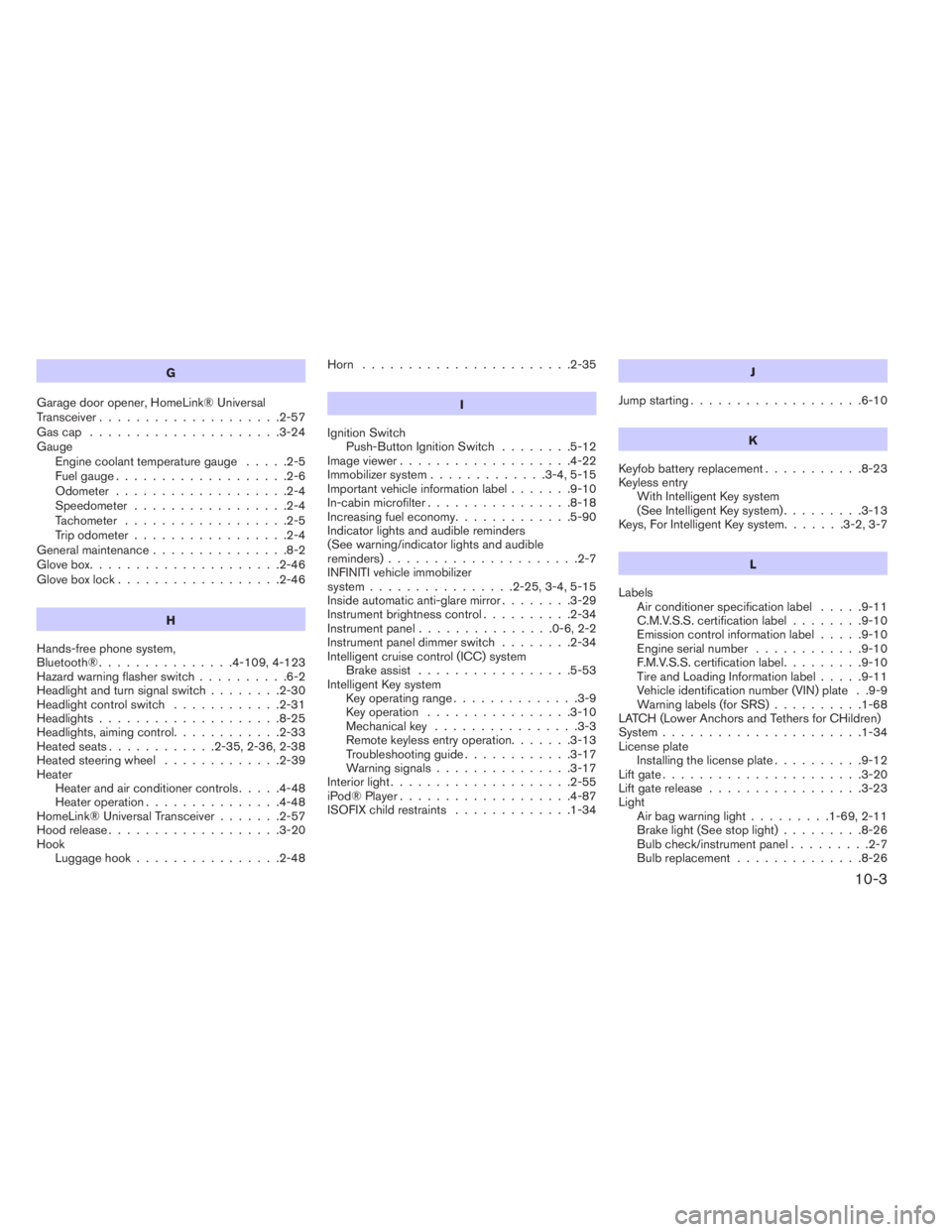
G
Garage door opener, HomeLink® Universal
Transceiver....................2-57
Gascap .....................3-24
Gauge
Engine coolant temperature gauge.....2-5
Fuel gauge...................2-6
Odometer...................2-4
Speedometer.................2-4
Tachometer..................2-5
Trip odometer.................2-4
Generalmaintenance...............8-2
Glovebox.....................2-46
Gloveboxlock..................2-46
H
Hands-free phone system,
Bluetooth®...............4-109, 4-123
Hazard warning flasher switch..........6-2
Headlightandturnsignalswitch........2-30
Headlightcontrolswitch ............2-31
Headlights....................8-25
Headlights,aimingcontrol............2-33
Heated seats............2-35,2-36,2-38
Heated steering wheel.............2-39
Heater
Heater and air conditioner controls.....4-48
Heater operation...............4-48
HomeLink® Universal Transceiver.......2-57
Hood release...................3-20
Hook
Luggage hook................2-48Horn .......................2-35
I
Ignition Switch
Push-Button Ignition Switch........5-12
Image viewer...................4-22
Immobilizer system.............3-4,5-15
Important vehicle information label.......9-10
In-cabin microfilter................8-18
Increasing fuel economy.............5-90
Indicator lights and audible reminders
(See warning/indicator lights and audible
reminders).....................2-7
INFINITI vehicle immobilizer
system................2-25,3-4,5-15
Inside automatic anti-glare mirror........3-29
Instrument brightness control..........2-34
Instrument panel...............0-6,2-2
Instrument panel dimmer switch........2-34
Intelligent cruise control (ICC) system
Brake assist.................5-53
Intelligent Key system
Key operating range..............3-9
Key operation................3-10
Mechanicalkey ................3-3
Remote keyless entry operation.......3-13
Troubleshooting guide............3-17
Warning signals...............3-17
Interiorlight....................2-55
iPod® Player...................4-87
ISOFIX child restraints.............1-34J
Jump starting...................6-10
K
Keyfob battery replacement...........8-23
Keyless entry
With Intelligent Key system
(See Intelligent Key system).........3-13
Keys, For Intelligent Key system.......3-2,3-7
L
Labels
Air conditioner specification label.....9-11
C.M.V.S.S. certification label........9-10
Emission control information label.....9-10
Engine serial number
............9-10
F.M.V.S.S. certification label.........9-10
Tire and Loading Information label.....9-11
Vehicle identification number (VIN) plate . .9-9
Warning labels (for SRS)..........1-68
LATCH (Lower Anchors and Tethers for CHildren)
System......................1-34
License plate
Installing the license plate..........9-12
Liftgate......................3-20
Lift gate release.................3-23
Light
Airbagwarninglight.........1-69, 2-11
Brake light (See stop light).........8-26
Bulb check/instrument panel.........2-7
Bulbreplacement..............8-26
10-3
Page 542 of 547
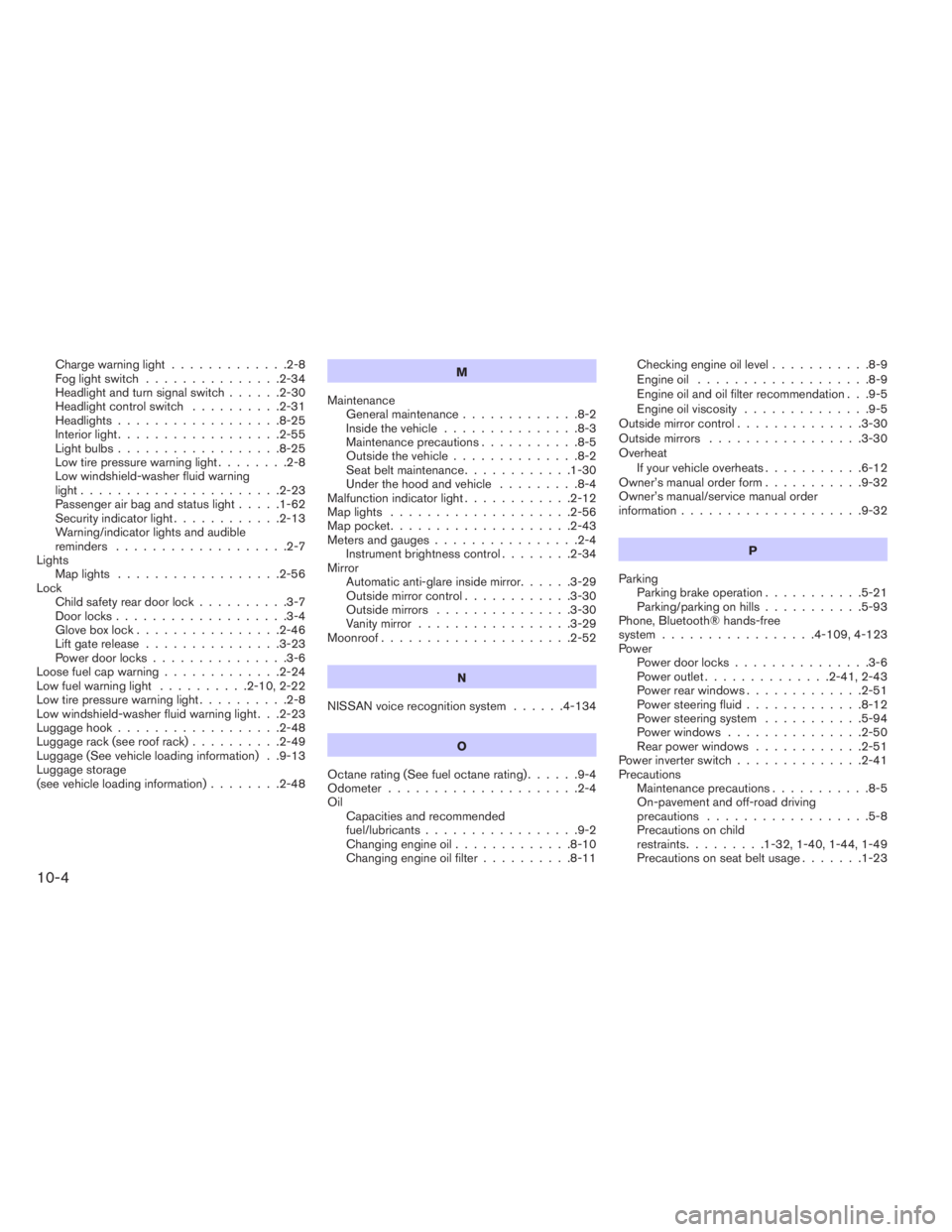
Chargewarninglight.............2-8
Foglightswitch ...............2-34
Headlight and turn signal switch......2-30
Headlightcontrolswitch ..........2-31
Headlights..................8-25
Interiorlight..................2-55
Lightbulbs..................8-25
Low tire pressure warning light........2-8
Low windshield-washer fluid warning
light......................2-23
Passenger air bag and status light.....1-62
Security indicator light............2-13
Warning/indicator lights and audible
reminders...................2-7
Lights
Maplights ..................2-56
Lock
Child safety rear door lock..........3-7
Door locks...................3-4
Gloveboxlock................2-46
Lift gate release...............3-23
Power door locks...............3-6
Loose fuel cap warning.............2-24
Lowfuelwarninglight ..........2-10,2-22
Low tire pressure warning light..........2-8
Low windshield-washer fluid warning light . . .2-23
Luggage hook..................2-48
Luggage rack (see roof rack)..........2-49
Luggage (See vehicle loading information) . .9-13
Luggage storage
(seevehicleloadinginformation)........2-48M
Maintenance
Generalmaintenance.............8-2
Insidethevehicle...............8-3
Maintenance precautions...........8-5
Outside the vehicle..............8-2
Seatbeltmaintenance............1-30
Underthehoodandvehicle .........8-4
Malfunction indicator light............2-12
Maplights ....................2-56
Map pocket....................2-43
Meters and gauges................2-4
Instrument brightness control........2-34
Mirror
Automatic anti-glare inside mirror......3-29
Outside mirror control............3-30
Outside mirrors...............3-30
Vanity mirror.................3-29
Moonroof.....................2-52
N
NISSAN voice recognition system......4-134
O
Octane rating (See fuel octane rating)......9-4
Odometer.....................2-4
Oil
Capacities and recommended
fuel/lubricants.................9-2
Changingengineoil.............8-10
Changing engine oil filter..........8-11Checking engine oil level...........8-9
Engine oil...................8-9
Engine oil and oil filter recommendation . . .9-5
Engine oil viscosity..............9-5
Outside mirror control..............3-30
Outside mirrors.................3-30
Overheat
If your vehicle overheats...........6-12
Owner’s manual order form...........9-32
Owner’s manual/service manual order
information....................9-32
P
Parking
Parking brake operation...........5-21
Parking/parking on hills...........5-93
Phone, Bluetooth® hands-free
system.................4-109, 4-123
Power
Power door locks...............3-6
Power outlet
..............2-41,2-43
Power rear windows.............2-51
Power steering fluid.............8-12
Power steering system...........5-94
Power windows...............2-50
Rear power windows............2-51
Power inverter switch..............2-41
Precautions
Maintenanceprecautions...........8-5
On-pavement and off-road driving
precautions ..................5-8
Precautions on child
restraints.........1-32,1-40,1-44,1-49
Precautions on seat belt usage.......1-23
10-4
Page 543 of 547
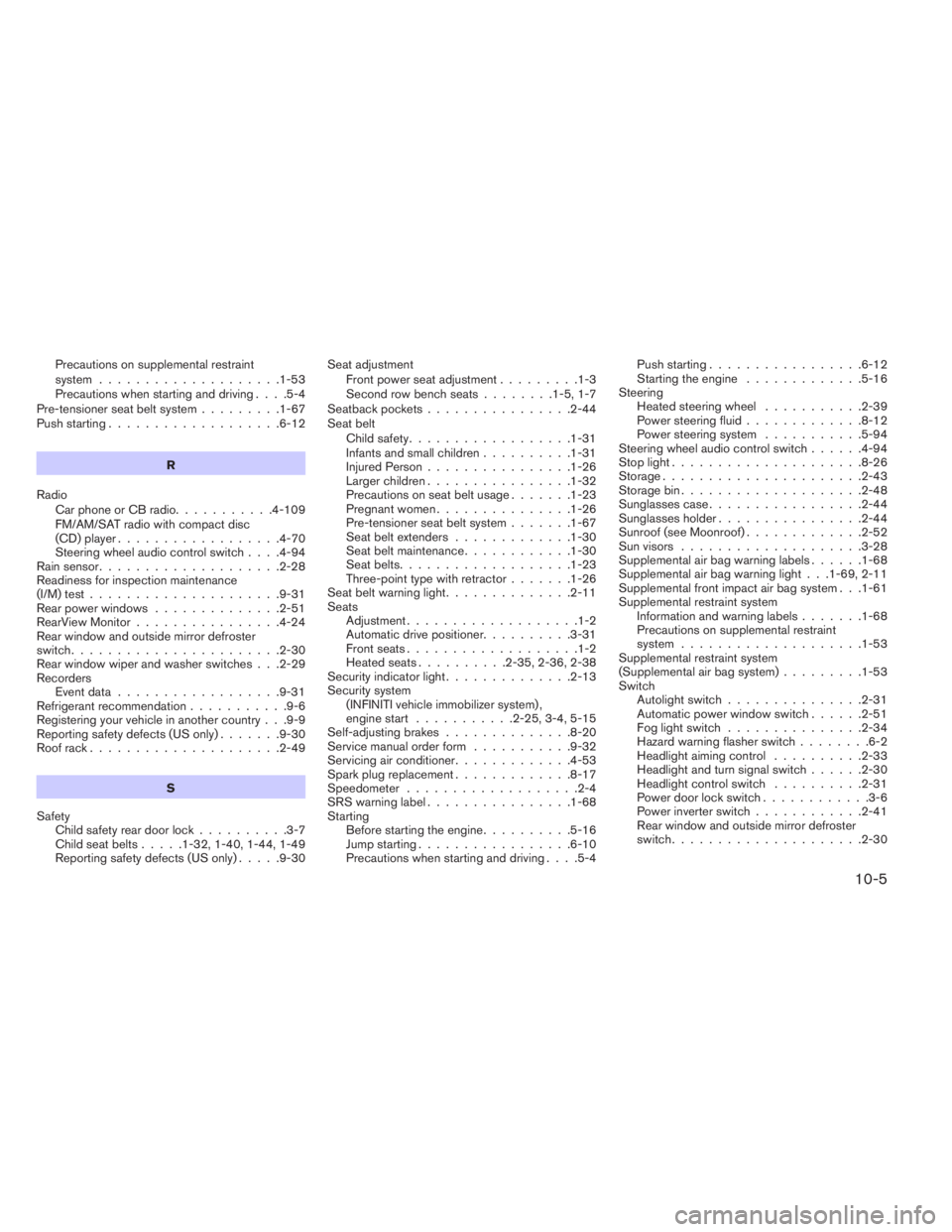
Precautions on supplemental restraint
system ....................1-53
Precautions when starting and driving....5-4
Pre-tensioner seat belt system.........1-67
Push starting...................6-12
R
Radio
Car phone or CB radio...........4-109
FM/AM/SAT radio with compact disc
(CD) player..................4-70
Steering wheel audio control switch....4-94
Rainsensor....................2-28
Readiness for inspection maintenance
(I/M) test.....................9-31
Rear power windows..............2-51
RearViewMonitor................4-24
Rear window and outside mirror defroster
switch.......................2-30
Rear window wiper and washer switches . . .2-29
Recorders
Eventdata..................9-31
Refrigerant recommendation...........9-6
Registering your vehicle in another country . . .9-9
Reporting safety defects (US only).......9-30
Roof rack.....................2-49
S
Safety
Child safety rear door lock..........3-7
Childseatbelts.....1-32,1-40,1-44,1-49
Reporting safety defects (US only).....9-30Seat adjustment
Front power seat adjustment.........1-3
Second row bench seats........1-5,1-7
Seatback pockets................2-44
Seat belt
Child safety..................1-31
Infants and small children..........1-31
Injured Person................1-26
Largerchildren................1-32
Precautions on seat belt usage.......1-23
Pregnant women...............1-26
Pre-tensioner seat belt system.......1-67
Seatbeltextenders .............1-30
Seatbeltmaintenance............1-30
Seatbelts...................1-23
Three-point type with retractor.......1-26
Seat belt warning light..............2-11
Seats
Adjustment...................1-2
Automatic drive positioner..........3-31
Frontseats...................1-2
Heatedseats..........2-35,2-36,2-38
Security indicator light..............2-13
Security system
(INFINITI vehicle immobilizer system) ,
engine start...........2-25,3-4,5-15
Self-adjusting brakes..............8-20
Service manual order form...........9-32
Servicing air conditioner.............4-53
Sparkplugreplacement.............8-17
Speedometer...................2-4
SRSwarninglabel................1-68
Starting
Before starting the engine..........5-16
Jump starting.................6-10
Precautions when starting and driving....5-4Push starting.................6-12
Starting the engine.............5-16
Steering
Heated steering wheel...........2-39
Power steering fluid.............8-12
Power steering system...........5-94
Steering wheel audio control switch......4-94
Stoplight.....................8-26
Storage......................2-43
Storagebin....................2-48
Sunglasses case.................2-44
Sunglasses holder................2-44
Sunroof (see Moonroof).............2-52
Sun visors....................3-28
Supplemental air bag warning labels......1-68
Supplemental air bag warning light . . .1-69, 2-11
Supplemental front impact air bag system . . .1-61
Supplemental restraint system
Information and warning labels.......1-68
Precautions on supplemental restraint
system....................1-53
Supplemental restraint system
(Supplemental air bag system).........1-53
Switch
Autolight switch...............2-31
Automatic power window switch......2-51
Fog light switch...............2-34
Hazard warning flasher switch........6-2
Headlightaimingcontrol ..........2-33
Headlightandturnsignalswitch......2-30
Headlight control switch..........2-31
Power door lock switch............3-6
Power inverter switch............2-41
Rear window and outside mirror defroster
switch.....................2-30
10-5